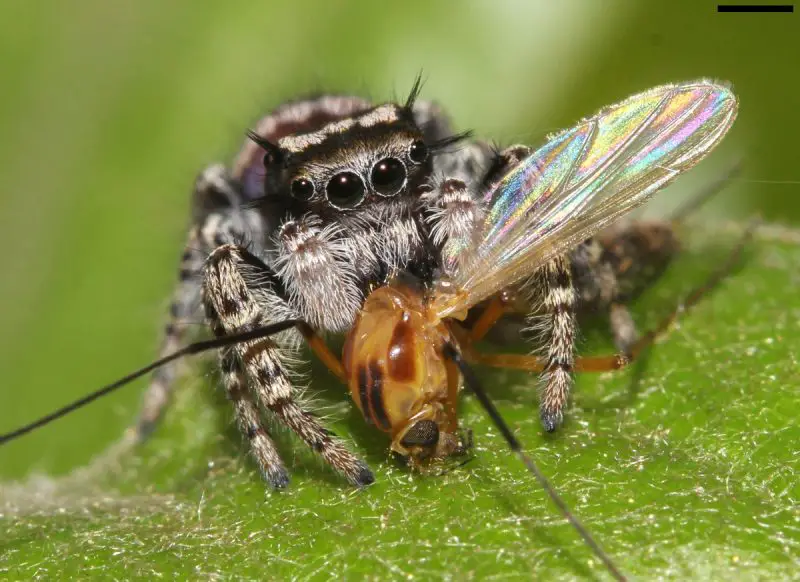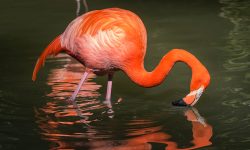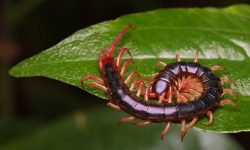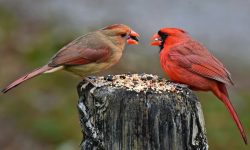Jumping spiders may be small, but they are some of the most skilled hunters in the arthropod world. Known for their incredible vision, agile leaps and bold personalities, these spiders actively stalk prey rather than waiting passively like web-builders. To maintain this active lifestyle, jumping spiders depend on a steady diet of nutrient-rich prey. Understanding what jumping spiders eat helps reveal how they survive in forests, grasslands, homes and gardens around the world.
Unlike many spiders that rely on silk traps, jumping spiders use careful observation and calculated pounces to capture prey. Their eyesight is among the best of all spiders, allowing them to track insects several times their size. Their diet reflects this hunting style: quick-moving prey, soft-bodied insects and tiny arthropods they can overpower easily. They also occasionally consume nectar or pollen, especially when insect prey is scarce.
This article explores 20 natural foods jumping spiders rely on, breaking down the prey types that fuel their energetic behavior, growth and daily activity. Whether you’re observing them in the wild or caring for one as a pet, this guide gives a clear look at their surprisingly diverse diet.
Understanding the Jumping Spider Diet

Jumping spiders are obligate carnivores, meaning they depend primarily on animal prey for nutrition. Their bodies are built for this lifestyle: sharp chelicerae for piercing, powerful legs for leaping, and large eyes that help track moving targets. Their ability to analyze motion and depth allows them to stalk prey with precision, making them one of the most successful tiny hunters in nature.
Because they burn a lot of energy during hunting, jumping spiders eat frequently. Small spiders feed on tiny insects daily, while larger species may eat every couple of days depending on prey availability. They prefer live food because movement triggers their hunting instincts. Once they choose a target, they approach slowly, leap forward and inject venom that quickly immobilizes the prey.
Though insects make up most of their diet, researchers have found that some jumping spiders occasionally consume nectar or pollen. These plant-based foods help sustain energy when prey is scarce, especially in dry or cooler seasons. This small dietary flexibility helps jumping spiders survive in a wide range of environments, from humid jungles to sunny windowsills.
20 Natural Foods Jumping Spiders Rely On
1. Fruit Flies
Fruit flies are ideal prey due to their tiny size and fast movement. Jumping spiders can easily track them with their excellent vision, making fruit flies a staple food for both wild and captive spiders. Their soft bodies are easy to consume.
In the wild, fruit flies gather around decaying fruit, compost or sweet plant materials. Jumping spiders often wait nearby and take advantage of these predictable feeding spots. Their jumping accuracy helps them catch flies mid-movement.
Because fruit flies are abundant in many climates, they provide consistent nutrition year-round, especially for young jumping spiders who need small, manageable prey.
2. Gnats
Gnats are another common food source, especially in humid environments. Their light, erratic flight patterns challenge jumping spiders, stimulating natural hunting behavior. Many spiders rely on gnats during rainy seasons.
Jumping spiders often ambush gnats near plants, windows or wet soil where gnats rest. Their quick reflexes and strong leaps allow them to intercept gnats before they fly away.
Gnats contain enough protein to support daily energy needs, making them a reliable part of a spider’s natural diet.
3. Mosquitoes
Mosquitoes are small enough for most jumping spiders to overpower. Their slow takeoff and tendency to land frequently make them easier targets than many flying insects. Spiders often catch mosquitoes as they rest on walls or leaves.
In nature, mosquitoes gather near standing water. Jumping spiders patrol these areas, taking advantage of the mosquitoes’ predictable landing habits. This helps control mosquito populations naturally.
Mosquitoes offer hydration as well as protein, because their bodies contain fluids that supplement a spider’s moisture needs.
4. Ants
Ants are common prey, though spiders choose species carefully. Some ants fight back with strong mandibles or formic acid, so jumping spiders usually target smaller or isolated individuals. Their speed gives them an advantage during ambushes.
Jumping spiders often wait near ant trails, picking off ants that wander too far from the colony. They use precise strikes to avoid the ant’s head and defensive bite.
Ants provide dense nutrients and are available in nearly every habitat, making them an important survival food.
5. Small Moths
Small moths make excellent prey due to their soft bodies and slow, fluttering flight. Jumping spiders often catch them in the early morning or evening when moths rest on surfaces.
Their large eyes help them detect subtle wing movements. Spiders slowly approach and then leap before the moth can react. This strategy works well when moths blend into bark or walls.
Moths contain high moisture and protein levels, providing balanced nutrition to active hunters.
6. Aphids
Aphids are tiny, abundant and easy for jumping spiders to overpower. These soft-bodied insects cluster on plant stems, giving spiders an easy opportunity to hunt without wasting energy.
Jumping spiders often patrol garden plants, picking off aphids that gather in large groups. Because aphids move slowly, they are ideal prey for juvenile spiders.
Their mild flavor and soft texture make them a consistent and safe food source across many ecosystems.
7. Leafhoppers
Leafhoppers are quick and alert, but jumping spiders can still catch them with well-timed leaps. These insects feed on plant sap, making them plentiful on leaves and stems.
Jumping spiders visually track leafhoppers, waiting for the right moment to pounce. Their depth perception helps them measure distance precisely before jumping.
Leafhoppers supply both protein and moisture, which benefits spiders in dry conditions.
8. Crane Fly Larvae
Crane fly larvae live in soil and leaf litter, where jumping spiders often forage. These larvae are soft and slow-moving, making them easy prey for ground-hunting species.
Jumping spiders use scent and movement detection to locate larvae beneath loose soil or decaying plants. Once found, they immobilize them quickly.
Larvae provide nutrient-dense meals, especially during seasons when adult insects are less active.
9. Tiny Roaches
Small roaches, particularly newly hatched ones, serve as food for larger jumping spiders. Roaches move quickly but are easier to predict than flies, allowing spiders to corner or ambush them.
Jumping spiders hunt roaches in dark corners, wood piles and behind leaves. Their ambush strategy minimizes the risk of injury.
These roaches offer substantial protein and contribute to the spider’s growth and strength.
10. Termites
Termites are soft-bodied and plentiful in certain regions. Jumping spiders find them in decaying wood, leaf litter or soil tunnels. Their abundance makes them an important prey source after rain.
Termite workers and nymphs are easy to catch. They provide energy-rich nutrition that fuels high activity levels.
Because termite populations can be large, jumping spiders benefit from seasonal colonies to support growth or egg production.
11. Beetle Larvae
Beetle larvae live under bark, soil and rotting logs. Jumping spiders explore these microhabitats to find larvae when insect prey above ground is scarce.
The larvae’s slow movement makes them easy targets. Their soft insides are nutrient-packed, supplying protein that young spiders especially need.
With their high moisture content, larvae also prevent dehydration, which is critical for smaller spider species.
12. Springtails
Springtails are extremely small but abundant in damp leaf litter and soil surfaces. They jump quickly, but jumping spiders, especially juveniles, are adapted to catching them with short, precise leaps.
Because springtails gather in groups, spiders can catch multiple prey in one area. Their size aligns perfectly with early spider developmental stages.
They form a core diet for young jumping spiders until the spiders can tackle larger insects.
13. Houseflies (Small Ones)
Jumping spiders often hunt small flies inside homes or outdoor areas. Their vision helps track fly movement patterns, allowing spiders to pounce when flies land momentarily.
Houseflies offer moderate protein and are accessible in human environments, making them a convenient food source.
Jumping spiders near windows or kitchen corners often feed on these flies, providing natural pest control.
14. Gnats from Houseplants
Houseplant gnats cluster around moist soil, making them predictable prey for jumping spiders living indoors. Their slow, hovering motion is easy for spiders to lock onto.
Spiders often patrol pot edges, catching gnats when they take off or land. These tiny insects keep indoor jumping spiders well-fed without requiring large prey.
Gnats are soft-bodied, which helps with digestion and hydration.
15. Caterpillars (Very Small Species)
Small caterpillars provide a rich, soft meal for jumping spiders. While larger caterpillars are too dangerous, tiny ones are safe and easy to overpower.
Jumping spiders approach slowly and bite caterpillars behind the head to immobilize them. Caterpillars often feed in exposed locations, making them easy targets.
Their high moisture and nutrient content help support energy during active hunting periods.
16. Small Grasshoppers or Nymphs
Baby grasshoppers and nymphs are small enough for larger jumping spiders to catch. These prey items require careful stalking due to their strong legs and fast jumps.
Spiders rely on patience, stealth and quick directional changes to capture them. Nymphs provide solid protein, aiding muscle development.
Though less common in dense forests, they are regular prey in open grassy areas.
17. Nectar
Some species, such as Bagheera kiplingi, consume nectar when insects are limited. Even typical jumping spiders sip nectar occasionally for quick carbohydrates.
Nectar helps maintain energy between hunts, especially in hot or dry seasons. Spiders lap it from flowers or plant surfaces.
This behavior shows a surprising flexibility in their diet, helping them survive in diverse habitats.
18. Pollen
Jumping spiders sometimes eat pollen for additional nutrients. Pollen grains provide carbohydrates and trace proteins that supplement their insect diet.
Spiders consume pollen by licking it directly from flowers or collecting it off their legs after moving through blooms.
Though not a primary food, pollen can support survival when prey availability decreases.
19. Other Small Spiders
Jumping spiders occasionally prey on other spider species—especially those smaller or slower. They use their agility advantage to overpower rivals.
This behavior occurs mainly when insect prey is scarce. They may also target spiders trapped in webs or hiding under leaves.
Cannibalism between jumping spiders is rare but does occur, especially among juveniles.
20. Newly Hatched Insects
Newly hatched insects such as tiny crickets, roach nymphs and fly larvae make easy prey. Their slow movement and small size allow even young jumping spiders to capture them.
These insects are rich in protein and moisture, forming a critical food source in both the wild and captivity.
Jumping spiders rely on these vulnerable prey items during times when adult insect populations fluctuate.
FAQs About What Do Jumping Spiders Eat
What do jumping spiders eat most often?
Mostly small flying insects like fruit flies, gnats and mosquitoes.
Do jumping spiders eat ants?
Yes, especially small or isolated ants, though they avoid aggressive species.
Can jumping spiders eat plants?
They may occasionally sip nectar or consume pollen but rely on insects for nutrition.
Do jumping spiders need live food?
Yes. Movement triggers their hunting response.
Do jumping spiders bite humans?
Rarely, and their bites are harmless and mild.
How often do they eat?
Small spiders may eat daily; larger ones every 2–3 days.
Do jumping spiders drink water?
They drink droplets from surfaces like leaves or enclosure walls.
Can you feed them houseflies?
Yes, as long as the flies are small enough to handle safely.
Do they eat other spiders?
Occasionally, particularly smaller species or juveniles.
Do jumping spiders help control pests?
Absolutely—they reduce populations of flies, gnats and plant pests.
Final Thoughts
Jumping spiders may be tiny, but their diet reveals just how capable and adaptable they truly are. By understanding what jumping spiders eat, we gain insight into their hunting strategies, ecological importance and surprising versatility. From fruit flies and gnats to nectar and tiny larvae, their varied diet fuels the energetic leaps and sharp vision that make them such captivating creatures. Whether in the rainforest, your garden or your windowsill, jumping spiders play a quiet but vital role in balancing insect populations.






